Art, speculative biology/evolution, worldbuilding, characters
Don't wanna be here? Send us removal request.
Text

This is a larger image of the newest rough-draft map for the geology and mountain ranges of Jom'Gol !! Here you can see it with better detail (pls look at my last two posts for more information), where the darkest regions indicate the highest terrain, and the lighter ones indicate lower terrain.
By now you should recognize some of what I've been talking about in my previous two posts-- old mountain ranges have eroded into bluffs or small highlands, while new mountain ranges have developed into very large active orogenous zones. You may also notice the very strange geography going on where some older mountain ranges intersect with newer mountain-building zones, forming very interesting rock formations in the world. Lifting up the old cores of mountains into new higher formations is sure to be interesting worldbuilding-wise, once I get to biomes and precipitation and later on culture and exploration !!
Some other interesting formations include older Appalachian-like mountains being split in half due to faults in the south (Olivine Mts.), and a shallow-plate Laramide/Rocky Mtn. -like formation cutting across the center of the continent. This one is sure to create some interesting geology--and later on, climate zones-- for here we see examples of Basin-Range like crustal stretching (Diamond Mts.), uplifts of old mountain ranges (Black Opal, Flint, Zircon Mts.) and huge plateau drops (Sapphire Range).
There also is a lot going on with the Himalayan-like Quartz group Mts. converging together into a massive plateau larger than the width of North America, while also compressing ancient oceans into solitary seas within the plateau (Quartz, Rose Quartz, Smoky Quartz, Amethyst, old Galena, Chrysoberyl, and Tourmaline Oriental Mts. form this huge amalgam of old and new mountains within the plateau).
These are just some of the examples of cool geological features in the new mountain-rich world! Here is an image of the old Jom'Gol map for a rough comparison. Stay tuned for the new additions when I start digitally making this map AND for more tree of life stuff!

and as I attach this image of the old map, it begins to set in JUST how painful redoing all of it is going to be oh my Lord
#art#artists on tumblr#worldbuilding#jomgol#spec bio#spec evo#speculative biology#speculative evolution#speculative worldbuilding#is spec geo a thing ?#geology#geography#dnd maps#fantasy map#fantasy maps#mapmaking#maps#world building
18 notes
·
View notes
Text


Here are the other three panels of my new plate tectonics rough draft (please refer to my last post if you have literally no idea what I'm talking about-- this is a pt 2.)
As you can see with my previous descriptions, each mountain range is named with the mineral naming scheme, and each continent with the rock naming scheme. Older mountain ranges that aren't specifically having a mountain building event in the frame are just labeled with a 3-letter identifier for ease so it doesn't get crowded.
As you may notice, the older the mountain ranges are, the more they get eroded. If it wasn't clear already, the darker the markings on the paper, the higher the elevation. Over time you may see some very tall mountaisn being reduced to just a shady blur of graphite. Some very tall Himalayan-type mountain ranges shown in the beginning might be reduced to mere bluffs or shaved-down mountain cores by this point like the Ozarks.
You may notice in the last panel that it seems fairly similar to the current map of Jom'Gol-- and you would be correct. The idea with revamping the geology was not necessarily that the shapes of the continents were bothersome, but the mountain building events and tectonic activity that made those shapes were not accurate. So you might notice significant difference in where the mountain ranges are compared to others on the original map, and continent shapes have been slightly changed to suit the new geologic processes that have been at play ! I do not have names yet for the supercontinents that formed during this process, so I still have to think of those for when I do maps of the previous tectonics (oh yes that's right, I will be making full-scale digital maps based on these paper ones for every era). I was considering either Bedrock or Batholith for the "modern-day" Jomgolian supercontinent, but either could work for the previous supercontinent as well.
Anyways! A larger image of the final one will be shown soon and I'll compare it with the current map-- although the digital full-scale version of the final one will take a very very very long time to create haha
#art#artists on tumblr#worldbuilding#jomgol#spec bio#spec evo#speculative biology#speculative evolution#speculative worldbuilding#geology#is spec geo a thing ?#dnd maps#fantasy map#fantasy maps#mapmaking#maps#world building#plate tectonics
6 notes
·
View notes
Text


I've recently been disappointed at my old topography maps and plate tectonics for Jom'Gol. As I learn more about geology I look back and discover many inaccuracies in my previous maps, or things that were placed in seemingly random areas because the tectonics "just made sense". So, in the past week I have not been posting, I decided to revamp my world's geology to make the orography more genuine and scientifically accurate (also as a little tiny tree of life break for now).
First I start on paper, sketching out the rough ideas of the shapes of the continents and their movement to get a ballpark estimate of what type of orogeny is being used (Himalayan? Andean? Ural? Basin-Range? Slip-Strike? Laramide?, etc.).
This gives me a good idea at what mountain-building events are taking place, and which mountain ranges will change, erode, or affect other mountain building events later. This also will help me determine the geology of certain regions later when I redo my rock and mineral maps.
Then, I became dissatisfied with my previous "temp names" I have given locations. The idea with the temp names is to have a sort of basis for what to call areas (instead of Mountain Range #26-A-1 or something like that lol) BEFORE conlanging. Once I get to the proto-civilization part of worldbuilding, then obviously when I start designing languages, these mountain ranges and valleys and such will be "named by the people" in whatever language those sentient beings will use.
For now, however, that conlanging step is VERY far away. So I decided that instead of random names or strings of numbers, I could create a naming scheme for ease. I decided that geographic features like mountains would be named after various minerals, with the continents themselves being named after types of rocks. I thought it would be a good "neutral" way of having names without running out of name ideas or showing favoritism to certain things or regretting name decisions later.
So here are the first four for now-- the time between each of those is not yet exactly determined but you can kind of think of each frame being about 150-300 million year snapshots. I'll post more with more details later!
#art#artists on tumblr#worldbuilding#jomgol#spec bio#spec evo#speculative biology#speculative evolution#speculative worldbuilding#geology#fantasy worldbuilding#dnd maps#fantasy map#fantasy maps#maps#mapmaking#plate tectonics
9 notes
·
View notes
Text

Alien Tree of Life Overview - Part 2 Ediacaran-likes, Disc-likes, Fishnet-likes, and Peach Ring-likes
Continuing from our last post on the Jom'Gol Tree of Life, we get to some of these interesting more complex creatures. Moving up the very beginning of the tree, still from the last common ancestor of all animals, we get to the clade Grander. Grander is a simple organism that has made a very far development in comparison to other organisms. Grander contains vacuoles in its cells to absorb and digest nutrients, like all other animals do. However, this development that sets it apart is an opening-- some would go as far as to call it a mouth, but it is far less complex than that. From Grander, many many clades diverge; today we will be taking a look at just one, Erithrosperma.
Erithrosperma has opted for the digestive approach of having as many mouths as possible that feed into this "central opening" (mouth-esque-thing) that all Grander have. This has allowed many amazing body plans for Erithrosperms.
Some, like the Plasmoderms, which is a parent group of the Incromalience, Matloba, and Credoderms, opt to have bulbs that catch and absorb nutrients. These bulbs, which are either passive like Incromalience, active and controlled like Credoderms, or active and fully mobile like Matloba, have a mucus-like membrane over the top of the bulbs. These may or may not be toxic in some species (or in some, deliver a sharp dart filled with neurotoxin or even an electric sting for immobilization), and begin the process of dissolving the creature. Smaller chunks are taken from the bulbs and "swallowed" into the central chamber, which is also like a "stalk" for most species. All groups of Plasmoderma-- excluding Matloba (which are mobile and "swim" like bobbing lanes, undulating ribbons, or very rarely eel-like motion)-- are rooted into the seabed and will use strong "stalks" or buoyant air bladders to maintain their place. Some groups, most notably what the Incromalience are known for, will bury themselves within the seafloor and sprout up when food is detected.
The other group is the Orchinidae, which opted to have a fixed, radially symmetric amount of mouths around their central chamber. These groups evolved to have the central mouth/stomach part that all Grander have into a circular tube within their bodies, and make the center of themselves large vacant spaces for buoyancy or control.
Euclimorphs, including the Starfish-esque Euclicota and the Urchin-like Orchocota, have disconnected tubes that do not fully form into that aforementioned ring. Excluding the mostly stationary Orchocots, this group can unwind its central body to form long spindly shapes for seafloor walking or spiral spinning, or rewind and reattach to their body to form starfish-like, peach-ring-like, or sun-like shapes to attach to rocks. These guys have a mouth on the underside of them that opens to the central stomach, typically all the way around the underside of the body for Euclicots.
Ossalkind are a special and very old clade on Jom'Gol, representing some of the first non-sponge animals to step foot (they don't have feet) onto land. These strange things are variably-sized and variably-located geometric animals that use a rolling locomotion to travel. The geometric shape resembles stars that have long, ossified, mineralized spurs which are used as legs while they roll around. The end of each leg contains a cloacal mouth, complete with at least one concentric ring of teeth, and more often than not suction-like tube feet to climb up slopes or stick to objects while they feed. The interior of their bodies is hollow and contains all of their organs in a meaty core, which can be pulled to any part of their body by long tendons attached to the inside of the leg-ends. By pulling these tendons and squeezing the soft core to one side of the body, the center of gravity is shifted and they can move in that direction.
This Orchinidae group also contains the Gridkind and Calicota, which are fishnet-like organisms to capture larger fish. They function essentially like a fishnet, using various methods (passively floating or squeezing in Gridkind, neurotoxins and expanding methods in Calicota) to capture their prey or passive plankton. Both of these clades use an ammonia-water based circulation system to keep themselves connected and supplied, and can regenerate very easily.
The last group in Orchinidae is the Prototekradia, a very ancient clade that-- you guessed it-- used to be very populous but is now mostly extinct. Tekradia are flat discs that roll around while wheels or tires, containing sharp spiky fins to grab materials and food off of the seafloor. The center of the disk is buldged slightly, which contains the gaseous bladder for the wheel component to stay upright. The Seamines however, are fairly straightforward in their name. The gaseous bladder is most of the volume, and the spiky fins contain neurotoxins, barbs, or colloblast-like spikes to pierce prey. Like the name implies, they are rooted to the seafloor with a long collagenous or meat-like chain that can expand or contract depending on where the current level of food is most likely to flow by.
That's all the information that I have on these guys !! I really really enjoy the more "alien" ones on my world, and if you stay following my page long enough you will see very detailed explanations and breakdowns of these clades more!!
#art#artists on tumblr#worldbuilding#jomgol#spec bio#spec evo#speculative biology#speculative evolution#speculative worldbuilding#xenobiology#alien species#creature design#sea creatures#creature#speculative zoology#alien biology
16 notes
·
View notes
Text
Alien Tree of Life Overview - Part 1 Simple Sponge-like Organisms
Alright, since we're getting into the Jom'Gol tree of life a little bit more, I wanted to go over some of these simpler animal organisms on the bottom and explain the basic ideas of these groups. The bottom of our list starts off with some of the first animals groups on Jom'Gol, and the common ancestors for all animals on the planet today. The last common ancestor for animals, setting the defining point for all animals alive (although there are exceptions to these, they all have the same common ancestor), was heterotrophic, possessed a mitochondria-like organism for metabolizing, and has a hollow space within itself for storing digestive enzymes. From there, animals diverged into several different major forms.

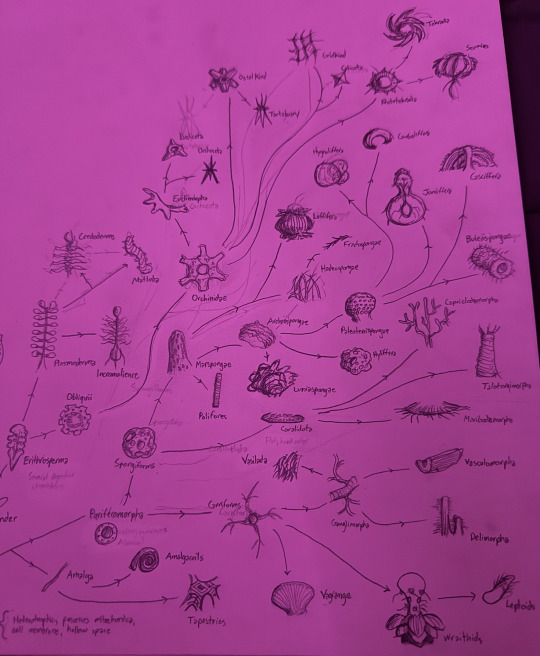
The simplest organisms opted for very simple passive nutrient absorption, collecting whatever minerals or proteins with a passive membrane and then absorbing it into the rest of its central body for ultimately simple digestion. This group diverged into the very simple extremophile Scoopuloids (not depicted on this illustration yet unfortunately, old photos lol), the Amalga, and the Poriferomorpha.
The Amalga once contained phyla with numerous species and a large presence on the planet, but are limited to location and species now. Extant groups include the Amalgacoils, simple mucus-like organisms that form incredibly small coil-like shapes in wet, extremophile, or seabed conditions where they can absorb passive nutrients-- and the Tapestries, which form quite large tarp-like shapes (true to their name) in vast subterranean cave systems to capture and digest any creature or small particulate that runs into it. The Poriferomorpha are the other branch, which contain the Spongiforms and the Carniforms. Carniforms, though once extensive in ancient Jom'Gol, now reside in mostly subterranean, cryptic, or subsurface environments. Their separation from the rest of the tree of life underground for so long after a mass extinction allowed them to take bizarre shapes and take advantage of otherwise untouched niches undergound. They are so named for several species' meat-like appearance, with many nutrient transportation systems mimicking the appearance of vessels. This is used to some species' advantage, as they use deceptive mimicry to attract animals into them to absorb their nutrients. Other species may find niches and body plans similar to that of sponges, coral, and some fungi-- only residing in subterranean environments most of the time. Spongiforms on the other hand resemble that of Earth sponges quite closely. They have a similar spongin-like structure of fibers to keep themselves rigid and a watery jellyfish-like mesoglea to keep structure and nutrients circulating around. They often grow into various different asymmetrical sizes similar to sponges to maximize surface area. Sponges are a huge component of Jom'Gol, as the entire planet was overrun by them for about a stretch of 1 billion years. The continued endurance of them has led to many different clades of these sponges, taking advantage of niches rarely seen.
Water-based sponges are seen fairly typically and may resemble earth sponges and earth coral. Some groups, like the Coralidota, use small proboscis-like tendrils to spread surface area even more when it detects nutrients available, and will resemble fixed coral shelves or tubes on the seabed. Other water sponges have opted to reside in tidal zones and far polar zones, using a combination of the spongin fibers and structures adapted from the mesoglea to retain heat and moisture in times lacking.
Extreme sponges have adapted to the deepest of the waters, in ocean trenches and extreme pressure zones. Some clades are even seen in deep-water caves, or hidden within sealed aqueducts and vugs deep underground.
Land sponges are one of the most versatile developments on Jom'Gol. Starting from costal-abiding spongiforms, land sponges eventually evolved to absorb their water and nutrients from fog, rain, flooding, brackish water, or plants and animals. Adaptations include many symbiotic relationships with plants, folding and unfolding "fans" to collect water, thick tissue and large fat-like water and nutrient reservoirs for desert-dwelling sponges, and even toxic-membraned bubble-like sponges to trap other animals into falling in to dissolve them.
That's all for today, I will cover those starfish-looking guys tomorrow in another post, because these posts are much lengthier than I thought they would be! Lots of exciting alien animals coming up !!
#art#artists on tumblr#worldbuilding#jomgol#spec bio#spec evo#speculative biology#speculative evolution#speculative worldbuilding#xenobiology#alien species#alien#speculative zoology#creature design#sea creatures#creature#alien biology
9 notes
·
View notes
Text

Hello everyone !! Lots more coming from the Jom'Gol tree of life very very soon-- I have a lot to post tomorrow and the day after and hopefully every day after that I will have something directly available every day !! Right as I had finished being busy and promised to post every other day, my phone shattered into a million pieces !!! SO I have been trying to fix this issue for a few days now and recover all my photos and notes on Jom'Gol fauna that I've saved on there and DIDN'T back up so kms but we good nowwwww !!!! I've covered some of the simple organisms already but all the rest of the life for animals will stem from this clade I'm pointing at-- complex animals and weird squid creatures coming up next! Thanks for your patience guys it feels like everything is preventing me from being able to work on this project but I prevail yet !!
#art#artists on tumblr#worldbuilding#jomgol#spec bio#spec evo#speculative biology#speculative evolution#speculative worldbuilding#xenobiology#creature design
6 notes
·
View notes
Text



ALIEN ANIMAL TREE OF LIFE
I have now started on my alien tree of life for animals !!! I have created a large 18x24 inch sheet of paper for which to outline the phylogeny of major animal groups on Jom'Gol.... this will get larger and larger until I fill out the entire page, as that is what I have planned the size of this chart will be !! For now, it just contains images of a major group with arrows proceeding towards descended groups, along with the name of that major group. While I have tried Greek/Latin naming schemes my last two attempts, I much rather enjoy creating arbitrary words for these creatures that "seem right" for now, at least for the larger nested groups of animals that might fall under "Phylum" or "Class" or even "Order". Families, Genus, Species, and all the subgrounds and inbetween clades will likely be the Greek-Latin names once I get to them, but I'll cross that bridge when I get there.
HOW TO READ THIS CHART:
Lines on this graph have little arrows indicating where the "descending group" is; so, following the arrows in the opposite direction gives you the parent group of the nested group. All drawings of the group are not just "an example species" like I've done in the past-- rather, the drawing depicts what the last common ancestor for all subgroups looked like.
If you reach a point on this graph where there are no more child groups remaining, always remember that there ARE, they just aren't depicted. Again, each of these are MAJOR groups of animals. Each "end-of-the-line" image depicted might only be on the level of "Class" or "Superorder"-- that means ALL of these still have subgroups and microclades and orders and families and genus and thousands and thousands of species.
All depicted groups are continuously alive groups on Jom'Gol-- clades of extinct creatures are not depicted on this chart. If a parent group has an image drawn and a name shown, this indicates that there is at least one clade of animals still alive on Jom'Gol that looks identical enough to the last common ancestor that creating a separate drawing would be exhaustive (mouthful sentence eugh). If that last sentence didn't mean anything to you, let me give you an example. For example, if Lycamptoda (depicted below) is a parent group to all these child groups (Largospermae, Millicarrii, Flexoid, Trillimouthes, Rosids), the image depicted on Lycamptoda is the LAST COMMON ANCESTOR (LCA) to all these child groups. Since this LCA is likely extinct, BUT it is still illustrated on the chart, this means that there is an IMPLIED child group NOT depicted on the chart-- since this implied child group looks so similar to the LCA, it is not shown nor depicted on the chart-- as it would be exhaustive for both me the creator, and you the viewer.

There is SOOOO much more to come from this chart ! I will try to continually post as I make this, and give descriptions to some of the more prominent groups on this chart as I go !! For now I've just attached images of some of the lower, simpler animals for you to look at to get you excited for the future!!! Stay tuned Jomgolians !!!
18 notes
·
View notes
Text



ALIEN ANIMAL TREE OF LIFE
I have now started on my alien tree of life for animals !!! I have created a large 18x24 inch sheet of paper for which to outline the phylogeny of major animal groups on Jom'Gol.... this will get larger and larger until I fill out the entire page, as that is what I have planned the size of this chart will be !! For now, it just contains images of a major group with arrows proceeding towards descended groups, along with the name of that major group. While I have tried Greek/Latin naming schemes my last two attempts, I much rather enjoy creating arbitrary words for these creatures that "seem right" for now, at least for the larger nested groups of animals that might fall under "Phylum" or "Class" or even "Order". Families, Genus, Species, and all the subgrounds and inbetween clades will likely be the Greek-Latin names once I get to them, but I'll cross that bridge when I get there.
HOW TO READ THIS CHART:
Lines on this graph have little arrows indicating where the "descending group" is; so, following the arrows in the opposite direction gives you the parent group of the nested group. All drawings of the group are not just "an example species" like I've done in the past-- rather, the drawing depicts what the last common ancestor for all subgroups looked like.
If you reach a point on this graph where there are no more child groups remaining, always remember that there ARE, they just aren't depicted. Again, each of these are MAJOR groups of animals. Each "end-of-the-line" image depicted might only be on the level of "Class" or "Superorder"-- that means ALL of these still have subgroups and microclades and orders and families and genus and thousands and thousands of species.
All depicted groups are continuously alive groups on Jom'Gol-- clades of extinct creatures are not depicted on this chart. If a parent group has an image drawn and a name shown, this indicates that there is at least one clade of animals still alive on Jom'Gol that looks identical enough to the last common ancestor that creating a separate drawing would be exhaustive (mouthful sentence eugh). If that last sentence didn't mean anything to you, let me give you an example. For example, if Lycamptoda (depicted below) is a parent group to all these child groups (Largospermae, Millicarrii, Flexoid, Trillimouthes, Rosids), the image depicted on Lycamptoda is the LAST COMMON ANCESTOR (LCA) to all these child groups. Since this LCA is likely extinct, BUT it is still illustrated on the chart, this means that there is an IMPLIED child group NOT depicted on the chart-- since this implied child group looks so similar to the LCA, it is not shown nor depicted on the chart-- as it would be exhaustive for both me the creator, and you the viewer.

There is SOOOO much more to come from this chart ! I will try to continually post as I make this, and give descriptions to some of the more prominent groups on this chart as I go !! For now I've just attached images of some of the lower, simpler animals for you to look at to get you excited for the future!!! Stay tuned Jomgolians !!!
#art#artists on tumblr#worldbuilding#jomgol#spec bio#spec evo#speculative biology#speculative evolution#speculative worldbuilding#speculative zoology#alien species#alien#creature design#creature#sea creatures#xenobiology#alien biology#world building#phylogeny
18 notes
·
View notes
Text


Thought of something the other day for a potential Jom'Gol game or something of the likes... I've been thinking about eventually making a ttrpg in my world sometime after a significant amount has been developed right? Something SORTA similar to D&D, but it would be my own thing with its own rules and whatnot. I thought about making a sort of "status effect" system for each player. Instead of just "You lose 2 HP", there's effects like "shattered bone"-- or something like that after a fight. I figured I could make Status Effect cards to give to my players depending on what effect it is, and how it affects gameplay.
So for example: You get a "Shattered bone" card. There would be a description on the card and then something like "Subtract 1d4 health every day without medical attention. Disadvantage on all 2 handed weapon attacks. -1d8 to all strength rolls."
(Just note that anything here is not a "type of disease" or specific name for a condition per se, it is more kind of states or conditions, symptoms, or groups of symptoms. So for example, "Shell shock" as opposed to saying "PTSD", or "Necrosing 3" under skin instead of "leprosy"-- the idea being that I would be giving players the cards so that they know the symptoms and conditions, NOT the specific disease thats causing these conditions/symptoms.
Not exactly sure how it could work but I thought it might be something fun to think about. This could also easily apply to some sort of Oregon Trail-esque game as well, but I haven't thought that crazy quite yet. Mostly this was just a one-off kind of idea spur that I thought could be fun. I can imagine a possible ttrpg scenario where there's only one conscious party member left and he's lost in a cave or something, and he has like 25 status effect cards and is rolling saving throws on a d20 every round to not succumb to Insanity IV LOL.
Anyways I started listing stuff out Possible status effects and theres a LOT of stuff, but i think the cards are a good way I could have complexity and keep it balanced and organized. Take a gander through if you would like or if you have any suggestions drop em lol.
#art#artists on tumblr#worldbuilding#jomgol#spec bio#spec evo#speculative biology#speculative evolution#speculative worldbuilding#speculative zoology#alien species#alien#world building#ttrpg#fantasy#dnd campaign#dnd
2 notes
·
View notes
Text


Hello Jom'Gol fans ! So sorry, I know I said delays were done but I just got back from taking my last checkride flight for my instrument rating. All done, so, I am now an instrument-rated pilot. YAY! NOW I should be all good to keep posting without interruptions for the summer ! A lot of worldbuilding to come! Didn't have time to type out the explanation for my next Jom'Gol tree of life post while I was there, so for now just take these two sketches I did while waiting for my paperwork in the airport lol Jomari eye close-up sketch on the left and some emo-looking-ass Jomari on the right
2 notes
·
View notes
Text

I've added more to this tree of life chart for Jom'Gol !! (Look at my previous post to explain the bottom portion of this chart). I have expanded up from Eukarya as a Domain and continued with a mostly normal taxonomy up to major Kingdoms. As you can see, many nested clades exist within this group, and split groups form a multitude of minor clades with the same rank as "Kingdom". Not sure what to call these yet, but these minor Kingdoms have significantly less species or diversity than the major Kingdom groups listed. Your major ones on this list of course include Animalia, Fungi, Chlorophylla, Retinalia, and Aerobiota!! There will be more detailed explanations of these later, but for now you can zoom in and see small little descriptions of each little split! I can't wait to go into full detail with every little branch on this tree later! My next addition to the Jom'Gol tree of life will begin from a point on this list, starting with the last common ancestor of a major Kingdom group... starting with the ever-popular ANIMAL Kingdom!
Stay tuned for more Jom'Gol !!!
#art#artists on tumblr#worldbuilding#jomgol#spec bio#spec evo#speculative biology#speculative evolution#speculative worldbuilding#speculative zoology#alien species#alien#phylogeny#tree of life
20 notes
·
View notes
Text

Here we are !!! I have begun to create a new tree of life for my world, replacing the old tree of life for Jom'Gol!!! This new one was made with significantly more understanding of biology and I am excited to work on this!! For the first, grander portion of this tree of life, I have decided to incorporate all sorts of forms of life that are not typically considered life here on Earth. While the origin of life may have multiple different fronts here on Earth, all forms of life (in this list) descended from one common successful chemical ancestor here on Jom'Gol. As you can see, this includes various Viruses, Viroids, "Ribozyds" (Ribosome-life simple replicating protein structures with no capsid shell), and various other forms of life. I have expanded on the traditional Linnean taxonomy which typically ends with Domain above Kingdom, and have added the ranks Realm above Domain, and World above Realm respectively to include our new life-adjacent buddies. Most complex forms of life you will see obviously descend from the Cellular Realm, which would be the traditional cutoff point for life here on Earth. More info and details soon for these guys, enjoy funny names and colors for now!!!
#art#artists on tumblr#worldbuilding#jomgol#spec bio#spec evo#speculative biology#speculative evolution#speculative worldbuilding#speculative zoology#speculative botany#alien species#phylogeny#biology
9 notes
·
View notes
Text



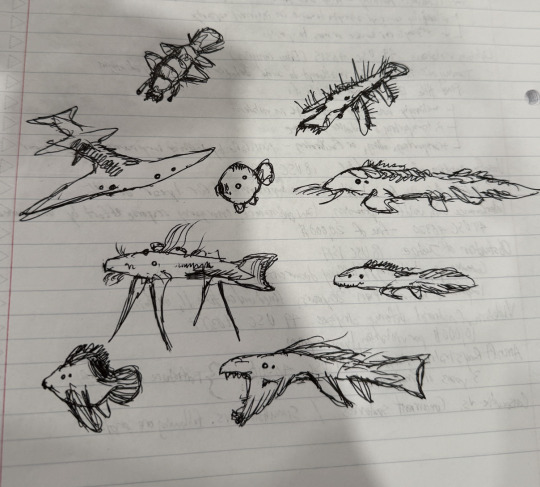


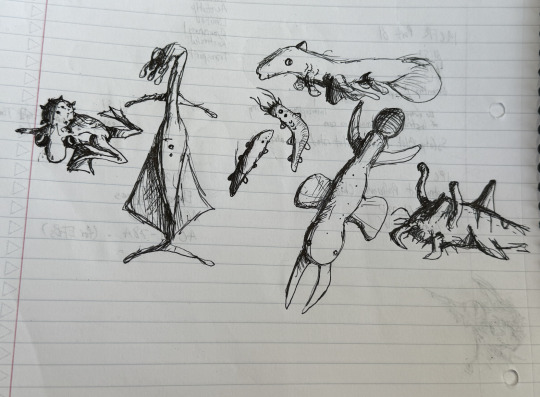

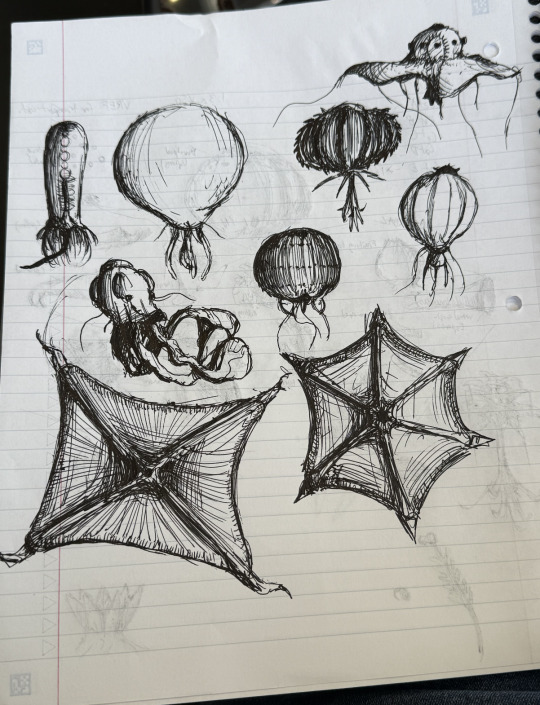


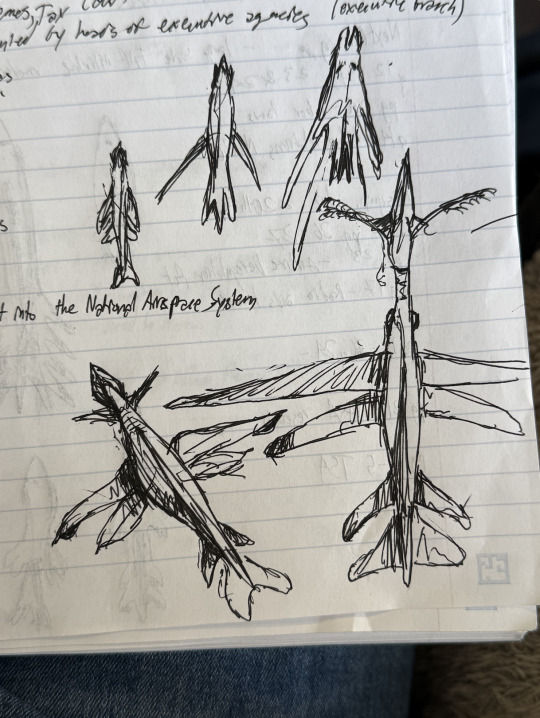
Hey guys, me again !!! So so so so so so soooooo sorry for the huge delay, life has been so overbearing recently. I've had to juggle my classes/exams with my two jobs and my flight training and trying to deal with training and tax paperwork and insurance problems and surgery so I have been SOOOOO busy--- unfortunately that means I have not had any time to work on Jom'Gol during the last two months other than some occasional sketches in between classes. So so sorry to my worldbuilding peeps and spec evo heads and my Jom'Gol fans, I didn't want my hiatus to be THIS long. Fortunately, I am less busy during this summer season-- and while I still have a lot to carry, I have significantly more time to work on my wonderful world!!! I've already started on a big project revamping my previous tree of life, and fixing some of the major fauna groups on Jom'Gol. I also have to begin fixing my old climate and weather and temperature systems as I have researched all the ways I've screwed up in the past! Regular posting will resume !!! As for now, please take a look at my aforementioned drawings and sketches of Jom'Gol fauna scribbled on my class notes:
#art#artists on tumblr#worldbuilding#jomgol#speculative biology#speculative evolution#speculative worldbuilding#my art#spec bio#spec evo#speculative zoology#alien species
12 notes
·
View notes
Text
Delays in worldbuilding
Sorry all my peeps who love and support my worldbuilding work for Jom'Gol. I'm really sorry for disappearing for a while, but unfortunately life has had other plans than letting me worldbuild. It's getting very busy to manage my school, my training and my job, and balance everything. I haven't had time to worldbuild this entire month and it doesn't look like the opportunity is presenting itself this next month either. Don't fret, this project is still my full passion and I fully intend to put my whole heart into it. I just have unfortunately been so clogged with work that I've had to sacrifice the time I usually set aside for worldbuilding for more life-pressing matters. I hope you all understand and thank you for your patience !!
7 notes
·
View notes
Text

A cargo hauler running into some engine trouble.
Attempted to mimic 1990s anime. Didn't quite get the look I wanted entirely but, I AM PROUD OF IT!
Unfiltered version

718 notes
·
View notes
Text


gughghghh (sorry I'm working on redoing some other things for the planet I don't have a ton to show for it atm)
Just in case you thought I was lying about the size of this continent on my planet compared with the size of Earth, here is the exact same distance measured out on GPlates (with the correct Jom'Gol radius entered) compared to distance measured with Google Earth. Both lengths are 8,928.7 kilometers :3
#art#artists on tumblr#digital art#worldbuilding#jomgol#spec bio#spec evo#speculative biology#speculative evolution#speculative worldbuilding#mapmaking#maps
15 notes
·
View notes
Text
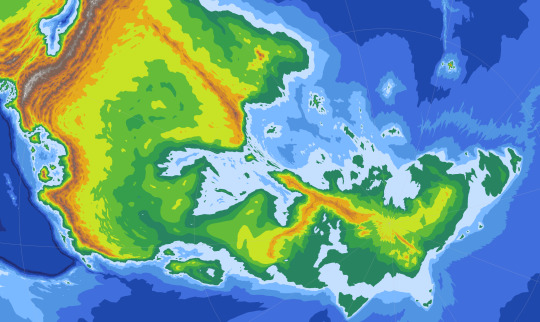
Here's a glorious view of the greater Bintheland (placeholder name) region with Jom'Gol's brand-new south pole map on GPlates. (North is towards the top left corner)
Fun fact, the left continent is as wide West-East as two United States West-East (Fictional continent width ~8900 km, USA width ~4320 km)
#art#artists on tumblr#digital art#worldbuilding#jomgol#spec bio#spec evo#speculative biology#speculative evolution#speculative worldbuilding#mapmaking#maps#fantasy maps#fantasy map#planets
20 notes
·
View notes